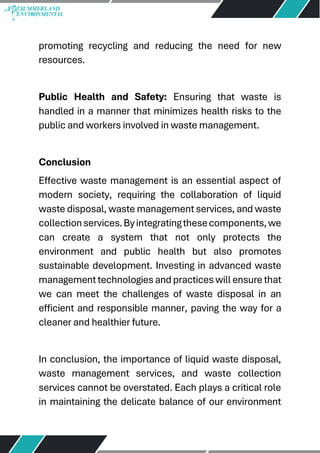Everything about Reclaim Waste
Everything about Reclaim Waste
Blog Article
Reclaim Waste Fundamentals Explained
Table of ContentsThe Best Guide To Reclaim WasteLittle Known Questions About Reclaim Waste.Unknown Facts About Reclaim WasteExamine This Report on Reclaim WasteExamine This Report on Reclaim Waste
Explore the types, occurrences, and types of fluid waste. Domestic sewage waste refers to the waste and items from a property septic storage tank. This kind of waste is created by people in houses, colleges, and other buildings. This only consists of septic tanks that have a drain area. The proper monitoring and disposal of residential sewer waste call for fluid waste to be moved to a sewage therapy plant where the appropriate approaches and equipment are put on detoxify and deal with waste.
Industrial waste usually includes potential risks, such as combustible materials or a combination of fluid and strong waste products, and requires a much more innovative and comprehensive disposal process. The disposal of business waste normally includes the filtering of waste before transport to ensure risk-free and proper disposal. Hazardous waste is developed from results and overflow of industrial procedures and production.
This sort of waste can not utilize the same sewage administration transport or processes as septic or business liquids. The hazardous waste monitoring procedure calls for the evaluation and testing of fluid waste prior to it goes through the disposal procedure (liquid waste disposal melbourne). Runoff waste is the liquid waste that comes from drainage and excess stormwater in highly populated locations or cities
Runoff waste can trigger contamination and flooding if not dealt with correctly. Ensuring correct waste monitoring can prevent calamities and decrease environmental harm.
The Best Strategy To Use For Reclaim Waste
Contact PROS Providers today to find out about our waste administration and disposal services and the correct methods to care for the liquid waste you generate.
(https://share.evernote.com/note/7e2c20e2-4e08-1523-1aa2-d06cf7e27761)Do you understand what occurs to your water when you end, flush the bathroom or drain pipes the cleaning maker? No? Well, it deserves recognizing. This supposed 'wastewater' is not only a vital resource but, after therapy, will be launched to our land, rivers or the ocean. Made use of water from bathrooms, showers, bathrooms, cooking area sinks, laundries and industrial processes is called wastewater.

water used to cool equipment or clean plant and devices). Stormwater, a type of wastewater, is drainage that streams from farming and urban locations such as roofs, parks, yards, roads, courses and rain gutters into stormwater drains pipes, after rainfall. Stormwater moves untreated straight to regional creeks or rivers, at some point getting to the sea.
The smart Trick of Reclaim Waste That Nobody is Talking About
In Queensland, many wastewater is treated at sewage therapy plants. Wastewater is delivered from residential or commercial websites via a system of drains and pump terminals, understood as sewerage reticulation, to a sewage therapy plant.
The Department of Natural Resources encourages city governments regarding handling, operating and preserving sewerage systems and go to this web-site treatment plants. In unsewered locations, city governments may call for homeowners to mount specific or home sewer treatment systems to treat residential wastewater from commodes, kitchens, shower rooms and laundries. The Department of Natural Resources authorises using home systems when they are proven to be reliable.
A lot of stormwater gets no therapy. In some new neighborhoods, therapy of some stormwater to remove litter, sand and gravel has actually begun making use of gross pollutant traps. Wastewater therapy takes place in 4 phases: Gets rid of strong matter. Larger solids, such as plastics and other items mistakenly discharged to sewage systems, are eliminated when wastewater is passed via displays.
Makes use of tiny living microorganisms recognizes as micro-organisms to break down and eliminate continuing to be dissolved wastes and fine fragments. Micro-organisms and wastes are included in the sludge.
The Definitive Guide to Reclaim Waste
Nutrient removal is not readily available at all sewage therapy plants since it calls for costly specialised tools. It is becoming more typical in Queensland. Clear liquid effluent generated after therapy may still consist of disease-causing micro-organisms. If this effluent is released right into waterways such as rivers or the sea, the micro-organisms will eventually die out.

Most wastewater streams into the sewage system. Under the Act, regional federal governments provide approvals and permits for eco relevant tasks (ERAs) entailing wastewater releases that could have a regional influence.
Little Known Facts About Reclaim Waste.
Surveillance supplies accurate information regarding water high quality and can verify that permit problems are being fulfilled. The info acquired with monitoring gives the basis for making water high quality choices.
Report this page